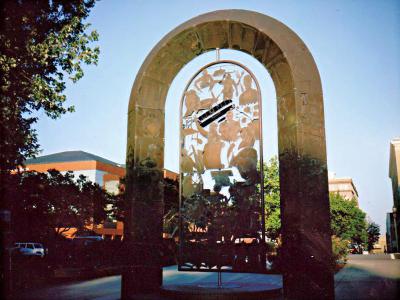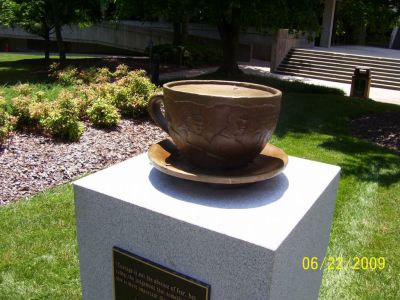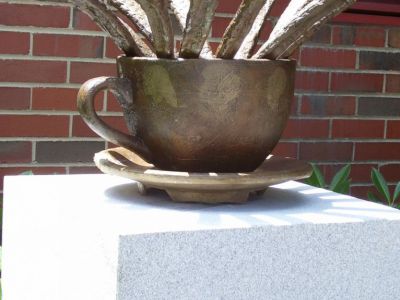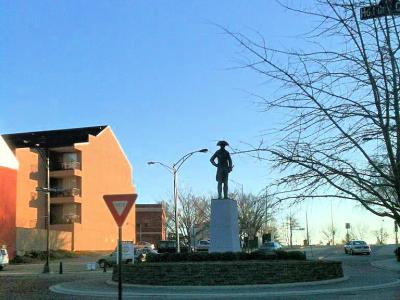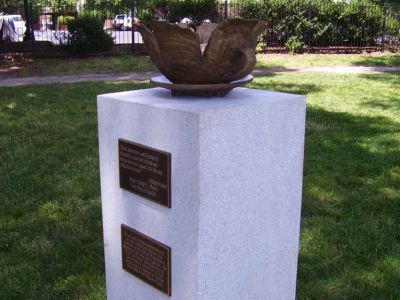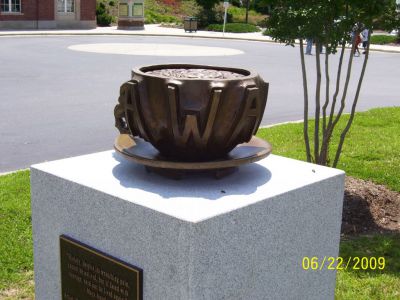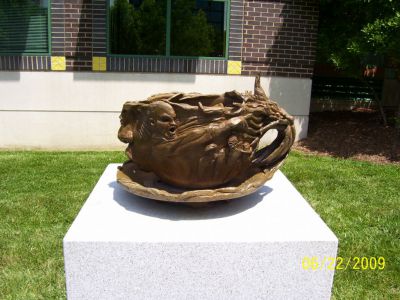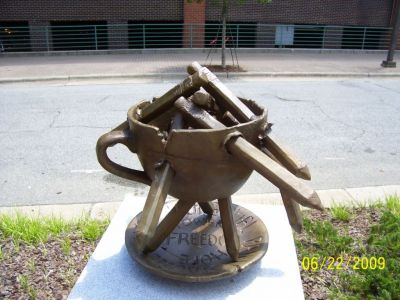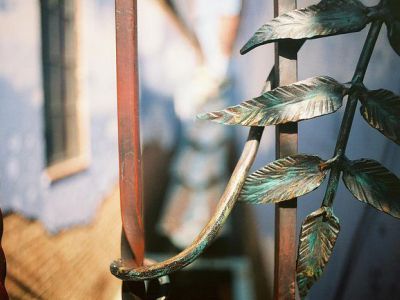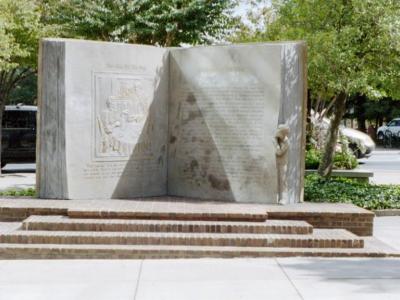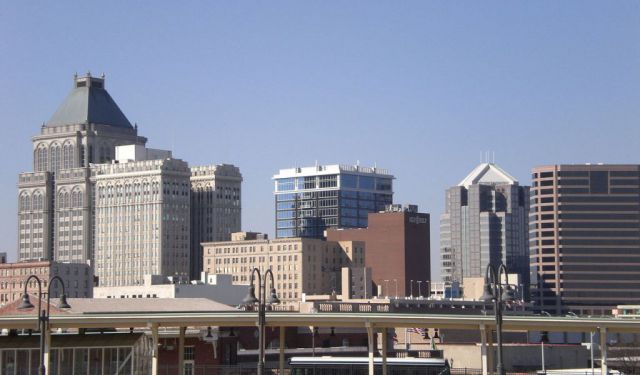Greensboro Downtown Statues and Monuments Walk (Self Guided), Greensboro
The birthplace of renowned author O Henry, Greensboro, North Carolina, also holds the distinction of harboring the genesis of the American Civil Rights Movement. Both these facts are commemorated in public artwork. Other esteemed personalities and notable chapters in the city's history also find reflection in a plethora of monuments and statues throughout Downtown.
Among these landmarks, the Millennium Gate stands out as a symbol of progress and unity – a gateway to the future. Nearby, the Overcome Sculpture commemorates resilience and triumph over adversity, serving as a poignant reminder of the community's strength, while the Spoons Sculpture adds a touch of whimsy, inviting visitors to interact with its playful design.
At the heart of Downtown, the Statue of Nathanael Greene honors the city's namesake, a Revolutionary War hero whose legacy looms large. Not far away, the Pearl of Equity Sculpture embodies the ongoing pursuit of justice and equality in Greensboro. Meanwhile, the Awake Coffee Cup Sculpture symbolizes the call to action against indifference, serving as a reminder of the necessity for vigilance and engagement in addressing social issues and fostering positive change.
Further exploration reveals the thought-provoking In the Face of Strange Fruit Sculpture, which confronts issues of race and injustice. Literary enthusiasts will appreciate O Henry's Book, a tribute to the renowned author who called Greensboro home.
As visitors wander through Downtown, they encounter the Metaphor Statue, a striking work of art that embodies human aspiration and potential. The Education Cup Sculpture symbolizes the challenges confronted by black students in their educational journey, featuring a cup pierced by pencils to represent the barriers faced.
Each of these statues and monuments adds a great deal of character to the vibrant cityscape and tells a story, inviting viewers to engage with Greensboro's past, present, and future. So, plan your visit today and, perhaps, this will be the best time to experience what Downtown Greensboro has to offer!
Among these landmarks, the Millennium Gate stands out as a symbol of progress and unity – a gateway to the future. Nearby, the Overcome Sculpture commemorates resilience and triumph over adversity, serving as a poignant reminder of the community's strength, while the Spoons Sculpture adds a touch of whimsy, inviting visitors to interact with its playful design.
At the heart of Downtown, the Statue of Nathanael Greene honors the city's namesake, a Revolutionary War hero whose legacy looms large. Not far away, the Pearl of Equity Sculpture embodies the ongoing pursuit of justice and equality in Greensboro. Meanwhile, the Awake Coffee Cup Sculpture symbolizes the call to action against indifference, serving as a reminder of the necessity for vigilance and engagement in addressing social issues and fostering positive change.
Further exploration reveals the thought-provoking In the Face of Strange Fruit Sculpture, which confronts issues of race and injustice. Literary enthusiasts will appreciate O Henry's Book, a tribute to the renowned author who called Greensboro home.
As visitors wander through Downtown, they encounter the Metaphor Statue, a striking work of art that embodies human aspiration and potential. The Education Cup Sculpture symbolizes the challenges confronted by black students in their educational journey, featuring a cup pierced by pencils to represent the barriers faced.
Each of these statues and monuments adds a great deal of character to the vibrant cityscape and tells a story, inviting viewers to engage with Greensboro's past, present, and future. So, plan your visit today and, perhaps, this will be the best time to experience what Downtown Greensboro has to offer!
How it works: Download the app "GPSmyCity: Walks in 1K+ Cities" from Apple App Store or Google Play Store to your mobile phone or tablet. The app turns your mobile device into a personal tour guide and its built-in GPS navigation functions guide you from one tour stop to next. The app works offline, so no data plan is needed when traveling abroad.
Greensboro Downtown Statues and Monuments Walk Map
Guide Name: Greensboro Downtown Statues and Monuments Walk
Guide Location: USA » Greensboro (See other walking tours in Greensboro)
Guide Type: Self-guided Walking Tour (Sightseeing)
# of Attractions: 10
Tour Duration: 2 Hour(s)
Travel Distance: 2.7 Km or 1.7 Miles
Author: ellen
Sight(s) Featured in This Guide:
Guide Location: USA » Greensboro (See other walking tours in Greensboro)
Guide Type: Self-guided Walking Tour (Sightseeing)
# of Attractions: 10
Tour Duration: 2 Hour(s)
Travel Distance: 2.7 Km or 1.7 Miles
Author: ellen
Sight(s) Featured in This Guide:
- Millennium Gate
- Overcome Sculpture
- Spoons Sculpture
- Statue of Nathanael Greene
- Pearl of Equity Sculpture
- Awake Coffee Cup Sculpture
- In the Face of Strange Fruit Sculpture
- Education Cup Sculpture
- Metaphor Statue
- O. Henry's Book
1) Millennium Gate
The Millennium Gate stands as a striking testament to Greensboro's rich history and cultural heritage, captivating both residents and visitors alike since its unveiling in 2002. Situated at the Municipal Office Building on West Washington Street, this magnificent bronze sculpture was masterfully crafted by renowned local artist Jim Gallucci. Rising approximately 20 feet tall, the Millennium Gate commands attention with its imposing presence, adorned with a center rotating piece measuring about 6 feet wide and 14 feet tall.
As a symbol of the city's evolution and progress over the past millennium, the Millennium Gate is adorned with an array of intricate icons representing pivotal events, inventions, and figures that have left an indelible mark on Greensboro. Each icon serves as a poignant reminder of the city's vibrant history and contributions to various fields. For instance, the inclusion of a chair pays homage to Greensboro's esteemed furniture industry, which has played a significant role in shaping the local economy. Additionally, the Statue of Liberty serves as a poignant symbol of the profound impact of immigration on the United States, reflecting Greensboro's diverse and inclusive spirit.
As a symbol of the city's evolution and progress over the past millennium, the Millennium Gate is adorned with an array of intricate icons representing pivotal events, inventions, and figures that have left an indelible mark on Greensboro. Each icon serves as a poignant reminder of the city's vibrant history and contributions to various fields. For instance, the inclusion of a chair pays homage to Greensboro's esteemed furniture industry, which has played a significant role in shaping the local economy. Additionally, the Statue of Liberty serves as a poignant symbol of the profound impact of immigration on the United States, reflecting Greensboro's diverse and inclusive spirit.
2) Overcome Sculpture
The Overcome sculpture is a poignant tribute to the bravery and resilience of the participants of the Greensboro Sit-ins, a pivotal moment in the civil rights movement. As part of a larger art project initiated by The United Arts Council, The International Civil Rights Center and Museum, and Action Greensboro's synerG Group, the Overcome sculpture stands as one of eight coffee-cup sculptures scattered across the city. These sculptures collectively honor the courageous actions of the four men who initiated the sit-ins at the Woolworth lunch counter in 1960.
Created by artist Rodney Bennett, the Overcome sculpture is situated on the Melvin Municipal Building lawn on South Greene Street, serving as a tangible reminder of the enduring legacy of the civil rights struggle. The sculpture features a coffee cup adorned with a powerful quote by Ambrose Redmoon: "Courage is not the absence of fear, but rather the judgment that something else is more important than fear." This quote encapsulates the spirit of the sit-in participants, who faced immense challenges and opposition but remained steadfast in their commitment to justice and equality.
Through its thought-provoking message and artistic expression, the Overcome sculpture invites viewers to reflect on the significance of the Greensboro Sit-ins and the broader struggle for civil rights. It serves as a symbol of hope, resilience, and the power of collective action in confronting injustice and inspiring positive change.
Created by artist Rodney Bennett, the Overcome sculpture is situated on the Melvin Municipal Building lawn on South Greene Street, serving as a tangible reminder of the enduring legacy of the civil rights struggle. The sculpture features a coffee cup adorned with a powerful quote by Ambrose Redmoon: "Courage is not the absence of fear, but rather the judgment that something else is more important than fear." This quote encapsulates the spirit of the sit-in participants, who faced immense challenges and opposition but remained steadfast in their commitment to justice and equality.
Through its thought-provoking message and artistic expression, the Overcome sculpture invites viewers to reflect on the significance of the Greensboro Sit-ins and the broader struggle for civil rights. It serves as a symbol of hope, resilience, and the power of collective action in confronting injustice and inspiring positive change.
3) Spoons Sculpture
The Spoons Sculpture stands as a powerful testament to the spirit of the sit-in movement and the collective effort of students in their fight against injustice. Crafted by artist Leo Morrissey, the sculpture features a cup, spoons, and profiles of individuals, symbolizing the essence of the sit-in movement and the collaborative spirit of the students who participated. Morrissey's sculpture serves as a visual representation of resilience and unity in the face of oppression, highlighting the determination of individuals to stand up for their rights and effect positive change.
At the base of the sculpture lies a stone pedestal adorned with a bronze plaque, which includes a notable quote by John Fitzgerald Kennedy: "It is in the American tradition to stand up for one's rights - even if the new way to stand up for one's rights is to sit down." This quote encapsulates the essence of the sit-in movement and reflects the enduring legacy of those who courageously challenged segregation and discrimination through peaceful protest. Situated outside the Carolina Theatre on South Greene Street, the Spoons Sculpture serves as a poignant reminder of Greensboro's role in the civil rights movement and its commitment to fostering dialogue and understanding.
At the base of the sculpture lies a stone pedestal adorned with a bronze plaque, which includes a notable quote by John Fitzgerald Kennedy: "It is in the American tradition to stand up for one's rights - even if the new way to stand up for one's rights is to sit down." This quote encapsulates the essence of the sit-in movement and reflects the enduring legacy of those who courageously challenged segregation and discrimination through peaceful protest. Situated outside the Carolina Theatre on South Greene Street, the Spoons Sculpture serves as a poignant reminder of Greensboro's role in the civil rights movement and its commitment to fostering dialogue and understanding.
4) Statue of Nathanael Greene
The Statue of Nathanael Greene stands as a tribute to the legendary major general of the Continental Army during the American Revolutionary War and the namesake of Greensboro. Created by artist Jim Barnhill, this life-size bronze statue was installed at the roundabout of Greene and West McGee Streets in 2008. The statue commemorates Greene's significant contributions to American history as a patriot, statesman, and military leader, embodying the virtues and talents that defined his legacy.
Adorned with a plate on the pedestal featuring a quote by Marquis de Lafayette, the statue captures the essence of Greene's character and achievements. Lafayette's words, "In the very name Greene are remembered all the virtues and talents which can illustrate the patriot, the statesman, and the military leader," underscore the profound impact and lasting legacy of Nathanael Greene. As a prominent landmark in Greensboro, the statue serves as a reminder of the city's rich history and its connection to the ideals of freedom, courage, and leadership embodied by General Greene.
Adorned with a plate on the pedestal featuring a quote by Marquis de Lafayette, the statue captures the essence of Greene's character and achievements. Lafayette's words, "In the very name Greene are remembered all the virtues and talents which can illustrate the patriot, the statesman, and the military leader," underscore the profound impact and lasting legacy of Nathanael Greene. As a prominent landmark in Greensboro, the statue serves as a reminder of the city's rich history and its connection to the ideals of freedom, courage, and leadership embodied by General Greene.
5) Pearl of Equity Sculpture
The Pearl of Equity sculpture is a poignant representation of the civil rights struggle and the power of collective action. Crafted by local artist Timothy L. Daniel, the sculpture features a cup shaped like a flower with a pearl resting on an oyster shell. Symbolically, the pearl represents the ongoing struggle for civil rights, while the shell signifies the prevailing status quo. The flower embodies themes of renewal and rejuvenation, serving as a metaphor for the emergence of hope and progress.
Located in Hamburger Square on South Elm Street, the Pearl of Equity sculpture serves as a meaningful reminder of the city's history and its commitment to social justice. The sculpture is accompanied by a plate on the pedestal bearing a quote by anthropologist Margaret Mead: "Never doubt that a small group of thoughtful, committed citizens can change the world. Indeed, it is the only thing that ever has." This quote encapsulates the spirit of activism and the belief in the transformative power of collective efforts toward positive change, resonating deeply with the themes embodied by the Pearl of Equity sculpture.
Located in Hamburger Square on South Elm Street, the Pearl of Equity sculpture serves as a meaningful reminder of the city's history and its commitment to social justice. The sculpture is accompanied by a plate on the pedestal bearing a quote by anthropologist Margaret Mead: "Never doubt that a small group of thoughtful, committed citizens can change the world. Indeed, it is the only thing that ever has." This quote encapsulates the spirit of activism and the belief in the transformative power of collective efforts toward positive change, resonating deeply with the themes embodied by the Pearl of Equity sculpture.
6) Awake Coffee Cup Sculpture
The Awake Coffee Cup sculpture in Greensboro is a striking piece of public art by Kurt Gabriel that honors the city’s pivotal role in the American civil rights movement. Installed in front of the J. Douglas Galyon Depot on East Washington Street, the sculpture is part of the Coffee Cup Collaborative, a series of artworks commemorating the courageous actions of the Greensboro Four during the 1960 Woolworth’s lunch counter sit-ins.
The sculpture itself features a large coffee cup emblazoned with bold letters and wrapped in a symbolic chain. These elements represent both the simplicity of the student’s request for service and the heavy social restraints they challenged. The chain is a stark metaphor for the oppression they resisted, while the word Awake calls viewers to recognize the enduring importance of social justice and the ongoing need to confront indifference.
This artwork is more than a tribute-it’s a call to consciousness. By drawing attention to a seemingly ordinary object like a coffee cup, Gabriel highlights the power of small acts to spark major change. The sit-ins were, after all, about more than just a beverage-they were about dignity, equality, and demanding a seat at the table.
As part of a broader public art initiative, similar coffee cup sculptures can be found across downtown Greensboro, including one at the Greensboro Coliseum. Together, they form a walking trail of remembrance and education, linking past activism to present-day community awareness and pride.
The sculpture itself features a large coffee cup emblazoned with bold letters and wrapped in a symbolic chain. These elements represent both the simplicity of the student’s request for service and the heavy social restraints they challenged. The chain is a stark metaphor for the oppression they resisted, while the word Awake calls viewers to recognize the enduring importance of social justice and the ongoing need to confront indifference.
This artwork is more than a tribute-it’s a call to consciousness. By drawing attention to a seemingly ordinary object like a coffee cup, Gabriel highlights the power of small acts to spark major change. The sit-ins were, after all, about more than just a beverage-they were about dignity, equality, and demanding a seat at the table.
As part of a broader public art initiative, similar coffee cup sculptures can be found across downtown Greensboro, including one at the Greensboro Coliseum. Together, they form a walking trail of remembrance and education, linking past activism to present-day community awareness and pride.
7) In the Face of Strange Fruit Sculpture
"In the Face of Strange Fruit" stands as a poignant tribute to the enduring struggle for freedom and equality, crafted by artist Derrick Monk and inspired by the haunting lyrics of Billie Holiday's iconic song, "Strange Fruit." The sculpture captures the faces of individuals who have courageously fought against injustice, symbolizing the collective resilience and perseverance of those who have challenged societal norms and oppression. With each face telling a story of resilience and resistance, the sculpture serves as a powerful reminder of the ongoing quest for equality and human rights.
Situated on the lawn of the Greensboro Cultural Center on North Davie Street, "In the Face of Strange Fruit" occupies a prominent location that invites contemplation and reflection. The bronze sculpture, adorned with a quote by Antoine De Saint-Exupery, serves as a beacon of hope and solidarity, encouraging viewers to embrace diversity and recognize the inherent value in embracing differences. Through its evocative imagery and profound message, the sculpture embodies the spirit of inclusivity and serves as a catalyst for dialogue and social change within the community.
Situated on the lawn of the Greensboro Cultural Center on North Davie Street, "In the Face of Strange Fruit" occupies a prominent location that invites contemplation and reflection. The bronze sculpture, adorned with a quote by Antoine De Saint-Exupery, serves as a beacon of hope and solidarity, encouraging viewers to embrace diversity and recognize the inherent value in embracing differences. Through its evocative imagery and profound message, the sculpture embodies the spirit of inclusivity and serves as a catalyst for dialogue and social change within the community.
8) Education Cup Sculpture
The Education Cup sculpture stands as a poignant symbol of the challenges faced by black students in their pursuit of education. Crafted by artist Gregory B. Colleton Jr., this striking bronze sculpture features a cup pierced by pencils, serving as a powerful metaphor for the barriers and oppression encountered by black students within educational institutions.
Accompanied by a quote from Booker T. Washington, "I have learned that success is to be measured not so much by the position that one has reached in life as by the obstacles which he has overcome while trying to succeed," the sculpture encourages reflection on the resilience and determination required to overcome systemic inequalities.
Located adjacent to the Central Library on North Church Street, the Education Cup invites viewers to contemplate the importance of education as a tool for empowerment and social change.
Accompanied by a quote from Booker T. Washington, "I have learned that success is to be measured not so much by the position that one has reached in life as by the obstacles which he has overcome while trying to succeed," the sculpture encourages reflection on the resilience and determination required to overcome systemic inequalities.
Located adjacent to the Central Library on North Church Street, the Education Cup invites viewers to contemplate the importance of education as a tool for empowerment and social change.
9) Metaphor Statue
The Metaphor statue stands as a timeless symbol of human aspiration and potential. Crafted by the renowned artist Ogden Deal, this striking twelve-foot steel sculpture portrays a human figure reaching upward, its hands outstretched toward the sky. Symbolizing the innate human desire for growth, exploration, and transcendence, Metaphor has captivated the imagination of visitors and locals alike for nearly four decades.
Sponsored by the Greensboro Youth Council, Metaphor holds a special significance as a testament to the dreams and ambitions of the younger generation. Situated in Youth Square, at the intersection of Summit Avenue, East Lindsay Street, and Church Court, the statue serves as a focal point for community gatherings, reflection, and inspiration. Its prominent location underscores its role as a beacon of hope and possibility, inviting individuals of all ages to contemplate the boundless potential inherent within each person.
Sponsored by the Greensboro Youth Council, Metaphor holds a special significance as a testament to the dreams and ambitions of the younger generation. Situated in Youth Square, at the intersection of Summit Avenue, East Lindsay Street, and Church Court, the statue serves as a focal point for community gatherings, reflection, and inspiration. Its prominent location underscores its role as a beacon of hope and possibility, inviting individuals of all ages to contemplate the boundless potential inherent within each person.
10) O. Henry's Book
As you stroll along North Elm Street your attention may be drawn to a remarkable monument honoring the renowned writer William Sydney Porter, better known as O. Henry. This monument takes the form of a massive stone book, serving as a tribute to O. Henry's literary legacy and his deep connection to Greensboro, where he spent a significant portion of his life. Created by artist Maria J. Kirby-Smith and unveiled in 1985, the monument showcases two of O. Henry's beloved short stories, "The Gift of the Magi" and "The Ransom of Red Chief," depicted within its pages.
One striking feature of the monument is the sculpture of a young boy peering out from between the pages, bringing to life the imaginative worlds created by O. Henry's storytelling. Just a few steps away from the stone book, visitors can discover a life-size statue of O. Henry himself, accompanied by his beloved dog. This charming statue offers a glimpse into the author's persona and his affection for his loyal companion, further enriching the experience of exploring O. Henry's literary heritage in Greensboro.
One striking feature of the monument is the sculpture of a young boy peering out from between the pages, bringing to life the imaginative worlds created by O. Henry's storytelling. Just a few steps away from the stone book, visitors can discover a life-size statue of O. Henry himself, accompanied by his beloved dog. This charming statue offers a glimpse into the author's persona and his affection for his loyal companion, further enriching the experience of exploring O. Henry's literary heritage in Greensboro.
Walking Tours in Greensboro, North Carolina
Create Your Own Walk in Greensboro
Creating your own self-guided walk in Greensboro is easy and fun. Choose the city attractions that you want to see and a walk route map will be created just for you. You can even set your hotel as the start point of the walk.
Greensboro Introduction Walking Tour
Before the arrival of Europeans in this part of North Carolina, the present-day area of Greensboro was inhabited by the indigenous (Siouan-speaking) Saura people, who called it "an unbroken forest with thick undergrowth of huckleberry bushes, that bore a finely flavored fruit."
Quaker migrants from Pennsylvania, by way of Maryland, arrived here in about 1750. They bought land from... view more
Tour Duration: 2 Hour(s)
Travel Distance: 3.6 Km or 2.2 Miles
Quaker migrants from Pennsylvania, by way of Maryland, arrived here in about 1750. They bought land from... view more
Tour Duration: 2 Hour(s)
Travel Distance: 3.6 Km or 2.2 Miles
The Most Popular Cities
/ view all



